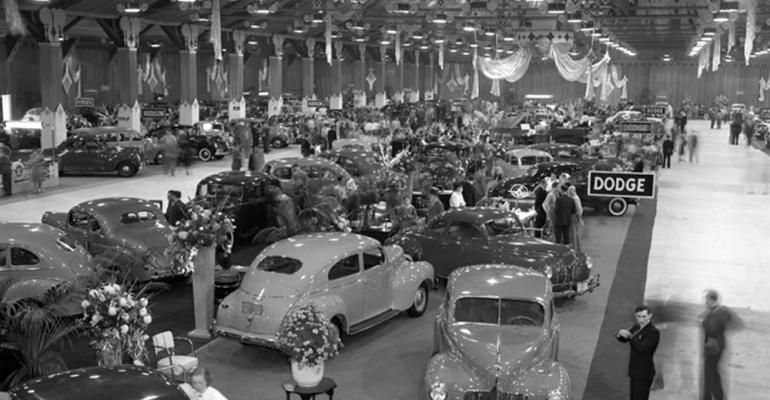75 Years Ago (November 1938): National Auto Show Opens; First Yearbook Published; Sun Roof Bows
With the 1939 National Automobile Show opening in New York City on Nov. 11, 1938, Ward’s Automotive Reports, in a Nov. 5, story, says that despite earlier new-model introductions, “It appears that a good deal of buying has been delayed until prospects can see all the cars side by side, and the rising momentum of business generally is likely to bring out good crowds.” However, “the drift of developments in the industry is acting this year to cut down on the predominant importance of the New York show.” Major shows in Detroit and Chicago will begin simultaneously and will be looked at as “guideposts of the forthcoming year just as significant as the outline of things to come drawn at New York.”
In a Nov. 12 auto show follow-up story, it is noted that “Automobile shows in New York, Chicago and Detroit opened a few hours before Ward’s went to press. A telephonic and telegraphic survey found large crowds at New York particularly interested in Cadillac and Buick among General Motors products, along with Hupp Skylark, Studebaker and Graham among the independents. The separate Ford-Mercury-Zephyr exhibit (also) attracted considerable attention.” Satisfactory crowds and “good buying” were reported from Chicago, while Detroit attendees showed, “considerable interest and buying earlier than usual.”
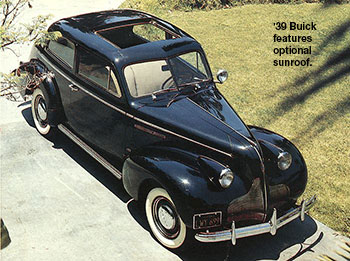 The Nov.12 issue also informs readers that Ward's 1939 Automotive Year Book, the first annual effort of its kind, came off the presses this week and is being mailed gratis to all subscribers of Ward’s Automotive Reports.” Attached to the book is a stamped, self-addressed postcard to be returned on receipt of the book. The card also provides a way to order additional books at $2.50 each. “Subsequent yearly editions will constantly be made more complete as our facilities permit.”
The Nov.12 issue also informs readers that Ward's 1939 Automotive Year Book, the first annual effort of its kind, came off the presses this week and is being mailed gratis to all subscribers of Ward’s Automotive Reports.” Attached to the book is a stamped, self-addressed postcard to be returned on receipt of the book. The card also provides a way to order additional books at $2.50 each. “Subsequent yearly editions will constantly be made more complete as our facilities permit.”
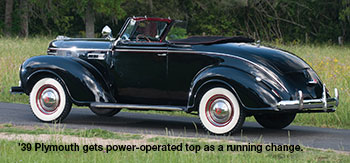 A successful innovation in Europe, GM’s Fisher Body is introducing the “sunshine top,” featuring a mechanism in which “a section roof slides back to open the front compartment to the sky.” Some “specialty buying” will undoubtedly be in the market for this body type in ’39 and “more will be manifested as the idea becomes less revolutionary.” At the same time, WAR says “well-grounded” reports indicate “a vacuum-operated disappearing convertible top will go into production shortly” for Dodge and Plymouth cars. The mechanism, operated by a control mounted on the instrument panel, will “undoubtedly meet substantial response” from potential ragtop buyers put off by the difficulty of manually raising and lowering a convertible top.
A successful innovation in Europe, GM’s Fisher Body is introducing the “sunshine top,” featuring a mechanism in which “a section roof slides back to open the front compartment to the sky.” Some “specialty buying” will undoubtedly be in the market for this body type in ’39 and “more will be manifested as the idea becomes less revolutionary.” At the same time, WAR says “well-grounded” reports indicate “a vacuum-operated disappearing convertible top will go into production shortly” for Dodge and Plymouth cars. The mechanism, operated by a control mounted on the instrument panel, will “undoubtedly meet substantial response” from potential ragtop buyers put off by the difficulty of manually raising and lowering a convertible top.
70 Years Ago (November 1943): Hunters Disrupt Schedules; Post-War Civilian Jeeps; 1943 Output Down 33%
Production schedules in Michigan’s war-materiel plants are being disrupted by workers seeking time off for deer hunting. “Deer hunting devotees among workers in such plants are determined to get their buck regardless of the needs of the boys in the foxholes of the battlefronts,” WAR opines. In one plant, making ball bearings and roller bearings, “critically needed for warplane production, 146 of the 750 people employed there are seeking time off for hunting. Some 1,500 of the 10,000 workers employed in a plant adjacent to Detroit, are taking time off to “participate in the deer-hunting season, which begins Nov. 15.”
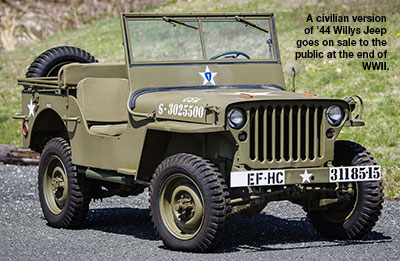 The latest installment in an on-going series titled The Cars of the Future, suggests that one manufacturer of “jeeps” has designed a series of models to “glorify this war vehicle as an adaption for early sales to civilians after the war ends.” In addition to a complete line of passenger cars based on the military “jeep,” plans call for production of a commercial car (panel van) and station wagon. The vehicle’s current 4-cyl. engine is expected to be used in civilian models, but in a standard rear-drive configuration. Four-wheel drive is expected to be optional. Developing a line of cars from a military vehicle already in production is seen as giving the auto maker a leg up on competitors that are estimated to require between three and six months to resume civilian car output at war’s end.
The latest installment in an on-going series titled The Cars of the Future, suggests that one manufacturer of “jeeps” has designed a series of models to “glorify this war vehicle as an adaption for early sales to civilians after the war ends.” In addition to a complete line of passenger cars based on the military “jeep,” plans call for production of a commercial car (panel van) and station wagon. The vehicle’s current 4-cyl. engine is expected to be used in civilian models, but in a standard rear-drive configuration. Four-wheel drive is expected to be optional. Developing a line of cars from a military vehicle already in production is seen as giving the auto maker a leg up on competitors that are estimated to require between three and six months to resume civilian car output at war’s end.
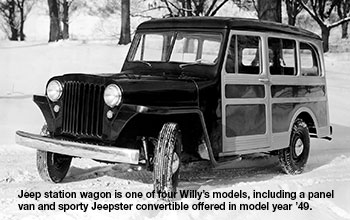 Vehicle production in the first nine months of 1943 is estimated at 721,900, down 33% from the 1,077,025 units built in like-1942. Labor and material shortages are blamed for the decline. Although still No.1, Ford output of 168,595 units is down sharply from prior-year’s 315,055. Dodge is second with output of 116,685 trucks as against 147,900 a year earlier, followed by Chevrolet, at 110,925 units vs. 183,085. Only GM Truck, 105,000 units vs. 93,331, Diamond T, 10,600 compared with 9,350, International, 10,650 units vs. 10,550 and Reo Truck, 2,995 vs. 2,742, built more vehicles so far this year compared with 1942.
Vehicle production in the first nine months of 1943 is estimated at 721,900, down 33% from the 1,077,025 units built in like-1942. Labor and material shortages are blamed for the decline. Although still No.1, Ford output of 168,595 units is down sharply from prior-year’s 315,055. Dodge is second with output of 116,685 trucks as against 147,900 a year earlier, followed by Chevrolet, at 110,925 units vs. 183,085. Only GM Truck, 105,000 units vs. 93,331, Diamond T, 10,600 compared with 9,350, International, 10,650 units vs. 10,550 and Reo Truck, 2,995 vs. 2,742, built more vehicles so far this year compared with 1942.
60 Years Ago (November 1953): Cheaper Tires Bow; Ford Leads Convertibles; Briggs Body Takeover; Prep Key to Lincoln Victory
Firestone has introduced the industry’s first lower-cost, lower-profit, “third-line” tire series in the post-WWII period. Initially available in two sizes, it is designed specifically to meet growing competition from independent tire merchandisers such as Sears Roebuck and Montgomery Ward, among others, that consistently maintain prices below those of nationally advertised brands. Firestone’s major rivals are expected to unveil similar products, perhaps before the end of the year. On a scale of 0-100, OEM tires are “rated at 100, second-line tires at between 72 and 80 and third liners at about 67,” according to WAR.
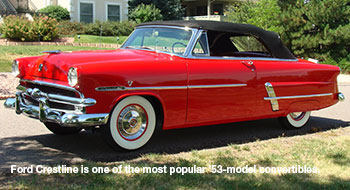 Ford is leading the charge in rising convertible output in 1953, while Buick is the chief builder of pillarless 2-door hardtops. Industry convertible production is expected to reach a third-best level of 165,000-plus units in 1953, trailing the record 205,987 built in 1950 and 1949’s second-best 203,234 units. Output of the hardtop, introduced in 1949, is forecast by WAR at a record 850,000 units. If achieved, that would represent a 53.5% increase the prior record of 553,797 built in 1952.
Ford is leading the charge in rising convertible output in 1953, while Buick is the chief builder of pillarless 2-door hardtops. Industry convertible production is expected to reach a third-best level of 165,000-plus units in 1953, trailing the record 205,987 built in 1950 and 1949’s second-best 203,234 units. Output of the hardtop, introduced in 1949, is forecast by WAR at a record 850,000 units. If achieved, that would represent a 53.5% increase the prior record of 553,797 built in 1952.
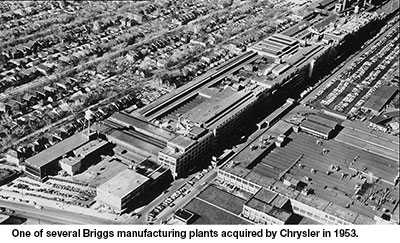 Packard may find itself between a rock and hard a place after Chrysler completes its takeover of body supplier Briggs Manufacturing. Chrysler is expected to assume complete control of Briggs sometime between Dec. 18 and Dec. 31. Although Packard’s supply of modestly restyled ’54-model bodies appears safe, WAR notes that it likely will have to find a new supplier for its redesigned ’55s. (After the Chrysler acquisition, the Conner Ave. Packard-body plant is sold to Packard, which uses it as a body manufacturing and assembly facility through the ’56 model year. After ’56, Packards become badge-engineered Studebakers built in South bend, IN.)
Packard may find itself between a rock and hard a place after Chrysler completes its takeover of body supplier Briggs Manufacturing. Chrysler is expected to assume complete control of Briggs sometime between Dec. 18 and Dec. 31. Although Packard’s supply of modestly restyled ’54-model bodies appears safe, WAR notes that it likely will have to find a new supplier for its redesigned ’55s. (After the Chrysler acquisition, the Conner Ave. Packard-body plant is sold to Packard, which uses it as a body manufacturing and assembly facility through the ’56 model year. After ’56, Packards become badge-engineered Studebakers built in South bend, IN.)
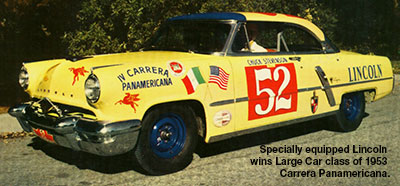 Diligent preparation was the key to Lincoln’s victory in the Large Car class of the 1953 Carrera Panamericana road race (an annual event first organized by the Mexican government in 1950 to celebrate the opening of the country’s portion of the Pan American highway. It is cancelled after 1954 – also a win for Lincoln – due to safety concerns.) “Before the race, chassis units were taken apart and checked for any possible metal fractures.” Non-stock features include “extra safety devices such as rollbars, heavy-duty sway bars and two shock absorbers on each suspension spring.” Additionally, the wheels are equipped with “air scoops” to cool the brakes.
Diligent preparation was the key to Lincoln’s victory in the Large Car class of the 1953 Carrera Panamericana road race (an annual event first organized by the Mexican government in 1950 to celebrate the opening of the country’s portion of the Pan American highway. It is cancelled after 1954 – also a win for Lincoln – due to safety concerns.) “Before the race, chassis units were taken apart and checked for any possible metal fractures.” Non-stock features include “extra safety devices such as rollbars, heavy-duty sway bars and two shock absorbers on each suspension spring.” Additionally, the wheels are equipped with “air scoops” to cool the brakes.
50 Years Ago (November 1963): Ward’s to Supply Data; Record Car Sales; Strikes Hit Car Stock; 8.0 Million Year Seen
WAR has been commissioned by Goodyear Tire and Rubber to supply “instant and continuous car production counts for the ‘colossal’ Goodyear sign being erected at the interchange of the Walter P. Chrysler (I-75) and Edsel Ford (I-94) freeways in Detroit.” The sign, using an electrically controlled odometer with 5-ft.-high numbers, will continuously tally car production. It will be illuminated at night by 19,000 light bulbs and is slated to be operational in mid-December, about the same time the new interchange opens. An estimated 200,000 vehicles will pass the sign daily. “It is the first time any sign in the world has been built for this purpose,” the newsletter says.
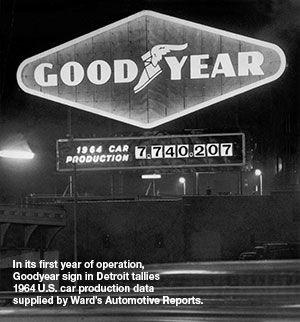 U.S. domestic-make new-car sales totaling 771,583 in October “shatters all monthly records.” The record tally bested by 5.9% the prior any-month benchmark of 728,552 units set a year earlier, in October 1962. Year-to-date 1963 sales totaled 6,045,000 units, 9.2% more than the 5,535,000 sold in like-1962 and second only to the 6,305,000 delivered in record-year 1955. If an estimated 320,000 imported cars are included, sales in the first 10 months of 1963 are slightly ahead of like-1955, when sales of import cars were estimated at 50,000 units.
U.S. domestic-make new-car sales totaling 771,583 in October “shatters all monthly records.” The record tally bested by 5.9% the prior any-month benchmark of 728,552 units set a year earlier, in October 1962. Year-to-date 1963 sales totaled 6,045,000 units, 9.2% more than the 5,535,000 sold in like-1962 and second only to the 6,305,000 delivered in record-year 1955. If an estimated 320,000 imported cars are included, sales in the first 10 months of 1963 are slightly ahead of like-1955, when sales of import cars were estimated at 50,000 units.
October strike losses of 26,000 units coupled with record sales leave Oct. 31 domestic-make new-car stock at a weak 27.4 days’ supply, or 782,300 units. Walkouts at GM plants in Norwood, OH; Doraville, GA; and South Gate, CA; account for more than 50% of the lost production, the bulk of it Chevrolet cars and light trucks. Strikes at Ford’s Kansas City, MO, and Metuchen, NJ, plants account for the remainder. In addition, strike votes have been taken at “over two dozen industry plants, all in protest of ’64-model production demands or standards.” Workers are seen rebelling against the demands of record-production levels mandating 9- and 10-hour shifts, with as many as 33 of the industry’s 46 plants working Saturday as well.
 More than 8.0 million cars may be built in the U.S. in 1963, 500,000-plus units more than current production schedules indicate. It is noted that at least one of the Big Three is unofficially forecasting that volume and taking steps to increase output in the final months of the year. If 8.0 million cars are built, it would beat the record 7,942,000 units turned out in 1955, by 7.3%.
More than 8.0 million cars may be built in the U.S. in 1963, 500,000-plus units more than current production schedules indicate. It is noted that at least one of the Big Three is unofficially forecasting that volume and taking steps to increase output in the final months of the year. If 8.0 million cars are built, it would beat the record 7,942,000 units turned out in 1955, by 7.3%.
25 Years Ago (November 1988): Diamond Star Opens; Light-Truck All-Wheel ABS;
Diamond-Star Motors, the Chrysler Mitsubishi joint venture, has begun building cars at its new assembly complex in Normal, IL. The Plymouth Laser and Mitsubishi Eclipse 2-door hatchbacks currently in production will be joined in 1989 by the Eagle Talon variant along with an Eagle Summit 4-door sedan. The Talon will be offered in both front- and all-wheel-drive variants. When at full production, the Normal assembly complex will be capable of building 63 cars hourly. That gives it the capacity to assemble 996 cars daily and 240,000 annually. Although the plant has no casting or machining capability, it molds the composite fascias used on the various models.
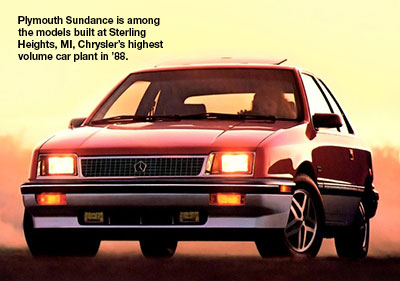 All-wheel antilock brakes are coming to light-trucks in model year ’89 on Jeep Cherokee and Wagoneer. GM light trucks adopt the system in ’90, along with Ford’s Aerostar van and large pickups. After that, the Ford Econoline large van will be the next to adopt ABS, according to industry reports. Many light trucks already feature rear-wheel ABS, once seen as a more cost-effective alternative to all-wheel designs. There were an estimated 1.5 million domestic-make cars and light trucks equipped with 2- or 4-wheel ABS in model year ’88, a figure seen growing exponentially – to as much as 100% of cars in ’95, according to one supplier forecast. One key to expanded use, according to Robert Bosch, is the development of a less complex, less costly, alternative to the current 4-channel system.
All-wheel antilock brakes are coming to light-trucks in model year ’89 on Jeep Cherokee and Wagoneer. GM light trucks adopt the system in ’90, along with Ford’s Aerostar van and large pickups. After that, the Ford Econoline large van will be the next to adopt ABS, according to industry reports. Many light trucks already feature rear-wheel ABS, once seen as a more cost-effective alternative to all-wheel designs. There were an estimated 1.5 million domestic-make cars and light trucks equipped with 2- or 4-wheel ABS in model year ’88, a figure seen growing exponentially – to as much as 100% of cars in ’95, according to one supplier forecast. One key to expanded use, according to Robert Bosch, is the development of a less complex, less costly, alternative to the current 4-channel system.
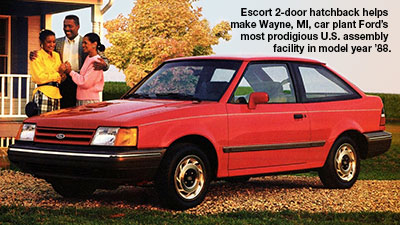 The Wayne, MI, facility was Ford’s leading U.S. car-assembly plant in the ’88 model year, turning out 298,397 Escorts. In second place, the Wixom, MI, facility built 280,661 ’88-model Lincoln Town Cars, Continentals and Marks. Lorain, OH, ranked third with 266,405 Ford Thunderbirds and Mercury Cougars completed. Edison, NJ, building 122,080 Escorts, was the auto maker’s lowest volume car facility. Meanwhile, the Sterling Heights, MI, facility was Chrysler’s top U.S. car builder in ’88. It turned out 233,342 ’88-model Chrysler LeBaron GTS, Dodge Shadow and Lancer, and Plymouth Sundance models.
The Wayne, MI, facility was Ford’s leading U.S. car-assembly plant in the ’88 model year, turning out 298,397 Escorts. In second place, the Wixom, MI, facility built 280,661 ’88-model Lincoln Town Cars, Continentals and Marks. Lorain, OH, ranked third with 266,405 Ford Thunderbirds and Mercury Cougars completed. Edison, NJ, building 122,080 Escorts, was the auto maker’s lowest volume car facility. Meanwhile, the Sterling Heights, MI, facility was Chrysler’s top U.S. car builder in ’88. It turned out 233,342 ’88-model Chrysler LeBaron GTS, Dodge Shadow and Lancer, and Plymouth Sundance models.

